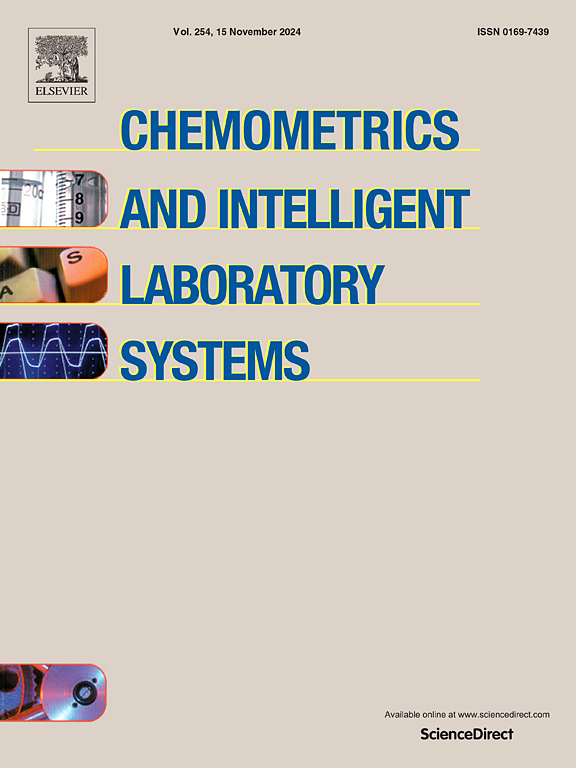基于智能手机的应用程序开发与机器学习使用芙蓉提取物pH值估计
IF 3.7
2区 化学
Q2 AUTOMATION & CONTROL SYSTEMS
Chemometrics and Intelligent Laboratory Systems
Pub Date : 2025-01-02
DOI:10.1016/j.chemolab.2024.105310
引用次数: 0
摘要
本研究提出了一种以芙蓉为天然pH指示剂的缓冲溶液的图像估计pH值的新方法。通过应用图像处理技术,将溶液的图像转换为标准化的200x200像素图像,每个图像显示不同的颜色,表明其pH值。在此基础上,利用自适应Boosting回归算法构建了pH预测模型。训练模型时使用的训练数据的pH值在0-14之间呈不规则分布。模型用94张图片和1880个实验值进行训练。此外,使用图像处理技术将可靠的预处理部分放入模型中,从而可以在任何所需的环境中获得测试数据。得到的训练和测试数据与噪声参数分离,对预测结果产生负面影响。基于该模型的智能手机应用程序已经开发出来,并可供所有人使用。这种创新的方法弥合了传统pH测量技术和计算机视觉之间的差距,提供了一种更容易获得和环保的pH评估手段。这项研究的实际应用扩展到各个领域,包括环境监测,农业和教育设置。本文章由计算机程序翻译,如有差异,请以英文原文为准。

Smartphone based app development with machine learning using Hibiscus sabdariffa L. extract for pH estimation
This study presents a novel approach for pH estimation in buffer solutions using images of solutions prepared with Hibiscus sabdariffa L. as a natural pH indicator. The images of the solutions, each displaying distinctive colours indicative of their pH levels, were transformed into standardized 200x200-pixel images through the application of image processing techniques. Following this, a pH prediction model was constructed using the Adaptive Boosting regressor algorithm. The pH values of the training data used when training the model were distributed irregularly between 0–14. The models were trained with 94 pictures and 1880 experimental values. In addition, a reliable pre-processing part has been placed into the model using image processing techniques, allowing test data to be obtained in any desired environment. The obtained training and test data were separated from noise parameters, affecting the prediction results negatively. A smartphone application based on the model has been developed and made available to everyone. This innovative methodology bridges the gap between traditional pH measurement techniques and computer vision, offering a more accessible and eco-friendly means of pH assessment. The practical applications of this research extend to various fields, including environmental monitoring, agriculture, and educational settings.
求助全文
通过发布文献求助,成功后即可免费获取论文全文。
去求助
来源期刊
CiteScore
7.50
自引率
7.70%
发文量
169
审稿时长
3.4 months
期刊介绍:
Chemometrics and Intelligent Laboratory Systems publishes original research papers, short communications, reviews, tutorials and Original Software Publications reporting on development of novel statistical, mathematical, or computer techniques in Chemistry and related disciplines.
Chemometrics is the chemical discipline that uses mathematical and statistical methods to design or select optimal procedures and experiments, and to provide maximum chemical information by analysing chemical data.
The journal deals with the following topics:
1) Development of new statistical, mathematical and chemometrical methods for Chemistry and related fields (Environmental Chemistry, Biochemistry, Toxicology, System Biology, -Omics, etc.)
2) Novel applications of chemometrics to all branches of Chemistry and related fields (typical domains of interest are: process data analysis, experimental design, data mining, signal processing, supervised modelling, decision making, robust statistics, mixture analysis, multivariate calibration etc.) Routine applications of established chemometrical techniques will not be considered.
3) Development of new software that provides novel tools or truly advances the use of chemometrical methods.
4) Well characterized data sets to test performance for the new methods and software.
The journal complies with International Committee of Medical Journal Editors'' Uniform requirements for manuscripts.

 求助内容:
求助内容: 应助结果提醒方式:
应助结果提醒方式:


